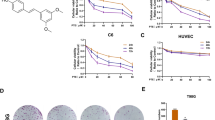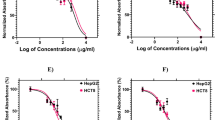Abstract
Malignant glioma is the most fatal, invasive brain cancer with limited treatment options. Our previous studies show that 2-(indol-3-ylmethyl)-3,3′-diindolylmethane (LTr1), a major metabolite of indole-3-carbinol (I3C) derived from cruciferous vegetables, produces anti-tumour effect against various tumour cell lines. In this study we characterized LTr1 as a novel anti-glioma agent. Based on screening 134 natural compounds and comparing the candidates’ efficacy and toxicity, LTr1 was selected as the lead compound. We showed that LTr1 potently inhibited the viability of human glioma cell lines (SHG-44, U87, and U251) with IC50 values of 1.97, 1.84, and 2.03 μM, respectively. Furthermore, administration of LTr1 (100,300 mg· kg−1 ·d−1, i.g. for 18 days) dose-dependently suppressed the tumour growth in a U87 xenograft nude mouse model. We demonstrated that LTr1 directly bound with TrkA to inhibit its kinase activity and the downstream PI3K/AKT pathway thus inducing significant S-phase cell cycle arrest and apoptosis in SHG-44 and U87 cells by activating the mitochondrial pathway and inducing the production of reactive oxygen species (ROS). Importantly, LTr1 could cross the blood-brain barrier to achieve the therapeutic concentration in the brain. Taken together, LTr1 is a safe and promising therapeutic agent against glioma through inhibiting TrkA/PI3K/AKT pathway.
This is a preview of subscription content, access via your institution
Access options
Subscribe to this journal
Receive 12 print issues and online access
$259.00 per year
only $21.58 per issue
Buy this article
- Purchase on Springer Link
- Instant access to full article PDF
Prices may be subject to local taxes which are calculated during checkout









Similar content being viewed by others
References
Baky MH, Shamma SN, Xiao J, Farag MA. Comparative aroma and nutrients profiling in six edible versus nonedible cruciferous vegetables using ms based metabolomics. Food Chem. 2022;383:132374.
Ahmed AG, Hussein UK, Ahmed AE, Kim KM, Mahmoud HM, Hammouda O, et al. Mustard seed (Brassica nigra) extract exhibits antiproliferative effect against human lung cancer cells through differential regulation of apoptosis, cell cycle, migration, and invasion. Molecules. 2020;25:2069.
Lenting K, Verhaak R, Ter Laan M, Wesseling P, Leenders W. Glioma: Experimental models and reality. Acta Neuropathol. 2017;133:263–82.
Yang K, Wu Z, Zhang H, Zhang N, Wu W, Wang Z, et al. Glioma targeted therapy: Insight into future of molecular approaches. Mol Cancer. 2022;21:39.
Lapointe S, Perry A, Butowski NA. Primary brain tumours in adults. Lancet. 2018;392:432–46.
Zhu WJ, Lin LP, Liu D, Qian JC, Zhou BB, Yuan DD, et al. Pharmacophore-inspired discovery of FLT3 inhibitor from kimchi. Food Chem. 2021;361:130139.
Lin LP, Liu D, Qian JC, Wu L, Zhao Q, Tan RX. Post-ingestion conversion of dietary indoles into anticancer agents. Natl Sci Rev. 2022;9:nwab144.
Thomson CA, Ho E, Strom MB. Chemopreventive properties of 3,3′-diindolylmethane in breast cancer: Evidence from experimental and human studies. Nutr Rev. 2016;74:432–43.
Yerushalmi R, Bargil S, Ber Y, Ozlavo R, Sivan T, Rapson Y, et al. 3,3-Diindolylmethane (DIM): A nutritional intervention and its impact on breast density in healthy BRCA carriers. A prospective clinical trial. Carcinogenesis. 2020;41:1395–401.
Liu X, Zhao P, Wang X, Wang L, Zhu Y, Song Y, et al. Celastrol mediates autophagy and apoptosis via the ROS/JNK and AKT/mTOR signaling pathways in glioma cells. J Exp Clin Cancer Res. 2019;38:184.
Ding Y, Zhou Y, Li Z, Zhang H, Yang Y, Qin H, et al. Oroxylin a reversed fibronectin-induced glioma insensitivity to temozolomide by suppressing IP3R1/Akt/β-catenin pathway. Life Sci. 2020;260:118411.
Yan Y, Liu X, Gao J, Wu Y, Li Y. Inhibition of TGF-β signaling in gliomas by the flavonoid diosmetin isolated from Dracocephalum peregrinum l. Molecules. 2020;25:192.
Jong L, Jiang F, Li G, Mortelmans K. Analogs of indole-3-carbinol and their use as agents against infection. US patent 20080097816P. 2010 Mar 25.
Bagal SK, Omoto K, Blakemore DC, Bungay PJ, Bilsland JG, Clarke PJ, et al. Discovery of allosteric, potent, subtype selective, and peripherally restricted TRKA kinase inhibitors. J Med Chem. 2019;62:247–65.
Morris GM, Huey R, Lindstrom W, Sanner MF, Belew RK, Goodsell DS, et al. AutoDock4 and AutoDockTools4: Automated docking with selective receptor flexibility. J Comput Chem. 2009;30:2785–91.
Son KH, Kim MY, Shin JY, Kim JO, Kang JH. Synergistic antitumor effect of taxanes and CDK4/6 inhibitor in lung cancer cells and mice harboring KRAS mutations. Anticancer Res. 2021;41:4807–20.
Ingham M, Schwartz GK. Cell-cycle therapeutics come of age. J Clin Oncol. 2017;35:2949–59.
Yadav V, Varshney P, Sultana S, Yadav J, Saini N. Moxifloxacin and ciprofloxacin induces s-phase arrest and augments apoptotic effects of cisplatin in human pancreatic cancer cells via erk activation. BMC Cancer. 2015;15:581.
Huang RX, Zhou PK. DNA damage response signaling pathways and targets for radiotherapy sensitization in cancer. Signal Transduct Target Ther. 2020;5:60.
Reed JC. Dysregulation of apoptosis in cancer. J Clin Oncol. 1999;17:2941–53.
Grilo AL, Mantalaris A. Apoptosis: A mammalian cell bioprocessing perspective. Biotechnol Adv. 2019;37:459–75.
Ren B, Cai ZC, Zhao XJ, Li LS, Zhao MX. Evaluation of the biological activity of folic acid-modified paclitaxel-loaded gold nanoparticles. Int J Nanomed. 2021;16:7023–33.
Yang C, Li Y, Hu W, Wang X, Hu J, Yuan C, et al. Teoa promotes autophagic cell death via ros-mediated inhibition of mTOR/p70s6k signaling pathway in pancreatic cancer cells. Front Cell Dev Biol. 2021;9:734818.
Elefantova K, Lakatos B, Kubickova J, Sulova Z, Breier A. Detection of the mitochondrial membrane potential by the cationic dye JC-1 in l1210 cells with massive overexpression of the plasma membrane abcb1 drug transporter. Int J Mol Sci. 2018;19:1985.
Wang Y, Long P, Wang Y, Ma W. Ntrk fusions and TRK inhibitors: Potential targeted therapies for adult glioblastoma. Front Oncol. 2020;10:593578.
Gambella A, Senetta R, Collemi G, Vallero SG, Monticelli M, Cofano F, et al. Ntrk fusions in central nervous system tumors: A rare, but worthy target. Int J Mol Sci. 2020;21:753.
Jiang T, Wang G, Liu Y, Feng L, Wang M, Liu J, et al. Development of small-molecule tropomyosin receptor kinase (Trk) inhibitors for ntrk fusion cancers. Acta Pharm Sin B. 2021;11:355–72.
Umezawa K, Lin Y. Inhibition of matrix metalloproteinase expression and cellular invasion by NF-κb inhibitors of microbial origin. Biochim Biophys Acta Proteins Proteom. 2020;1868:140412.
Conroy JN, Coulson EJ. High-affinity trka and p75 neurotrophin receptor complexes: A twisted affair. J Biol Chem. 2022;298:101568.
Wang H, Wang S, Wang R, Wang X, Jiang K, Xie C, et al. Co-delivery of paclitaxel and melittin by glycopeptide-modified lipodisks for synergistic anti-glioma therapy. Nanoscale. 2019;11:13069–77.
Mori N, Shimazu T, Sasazuki S, Nozue M, Mutoh M, Sawada N, et al. Cruciferous vegetable intake is inversely associated with lung cancer risk among current nonsmoking men in the japan public health center (jphc) study. J Nutr. 2017;147:841–9.
Gur C, Kandemir FM, Caglayan C, Satıcı E. Chemopreventive effects of hesperidin against paclitaxel-induced hepatotoxicity and nephrotoxicity via amendment of Nrf2/Ho-1 and caspase-3/Bax/Bcl-2 signaling pathways. Chem-Biol Interact. 2022;365:110073.
Halámková J, Adámková Krákorová D, Demlová R. Anisocoria as a side effect of paclitaxel treatment. Klinicka Onkol: Cas Ceske a Slovenske onkologicke spolecnosti. 2021;34:306–8.
Abu Samaan TM, Samec M, Liskova A, Kubatka P, Büsselberg D. Paclitaxel’s mechanistic and clinical effects on breast cancer. Biomolecules. 2019;9:789:1–22.
Gu W, Chen J, Patra P, Yang X, Gu Q, Wei L, et al. Nanoformulated water-soluble paclitaxel to enhance drug efficacy and reduce hemolysis side effect. J Biomater Appl. 2017;32:66–73.
Siozopoulou V, Smits E, De Winne K, Marcq E, Pauwels P. Ntrk fusions in sarcomas: Diagnostic challenges and clinical aspects. Diagnostics. 2021;11:478.
Nakagawara A. Trk receptor tyrosine kinases: A bridge between cancer and neural development. Cancer Lett. 2001;169:107–14.
Xu C, Ge S, Cheng J, Gao H, Zhang F, Han A. Pathological and prognostic characterization of craniopharyngioma based on the expression of TrkA, β-catenin, cell cycle markers, and BRAF V600E mutation. Front Endocrinol. 2022;13:859381.
Lagadec C, Meignan S, Adriaenssens E, Foveau B, Vanhecke E, Romon R, et al. TrkA overexpression enhances growth and metastasis of breast cancer cells. Oncogene. 2009;28:1960–70.
Miranda C, Mazzoni M, Sensi M, Pierotti MA, Greco A. Functional characterization of NTRK1 mutations identified in melanoma. Genes Chromosomes Cancer. 2014;53:875–80.
Oh TI, Lee YM, Nam TJ, Ko YS, Mah S, Kim J, et al. Fascaplysin exerts anti-cancer effects through the downregulation of survivin and HIF-1α and inhibition of VEGFR2 and TRKA. Int J Mol Sci. 2017;18:2074.
Wu T, Qin Q, Lv R, Liu N, Yin W, Hao C, et al. Discovery of quinazoline derivatives CZw-124 as a pan-TRK inhibitor with potent anticancer effects in vitro and in vivo. Eur J Med Chem. 2022;238:114451.
Lee HJ, Moon Y, Choi J, Heo JD, Kim S, Nallapaneni HK, et al. Characterization of KRC-108 as a TrkA kinase inhibitor with anti-tumor effects. Biomol Ther. 2022;30:360–7.
Viswanathan A, Kute D, Musa A, Konda Mani S, Sipilä V, Emmert-Streib F, et al. 2-(2-(2,4-dioxopentan-3-ylidene)hydrazineyl)benzonitrile as novel inhibitor of receptor tyrosine kinase and PI3K/Akt/mTOR signaling pathway in glioblastoma. Eur J Med Chem. 2019;166:291–303.
Nicholson JG, Fine HA. Diffuse glioma heterogeneity and its therapeutic implications. Cancer Discov. 2021;11:575–90.
Du ZW. [Establishment of human malignant glioma cell line (SHG-44) and observation on its characteristics]. Zhonghua Zhong Liu Za Zhi Chin J Oncol. 1984;6:241–3.
Kojadinovic A, Laderian B, Mundi PS. Targeting TRK: A fast-tracked application of precision oncology and future directions. Crit Rev Oncol/Hematol. 2021;165:103451.
Acknowledgements
This research was supported by grants from the National Key R&D Program of China (Nos. 2021ZD0202901 and 2018YFC1706205), and the National Natural Science Foundation of China (Nos. 81991523 and 82073721). We thank the Experiment Center for Science and Technology, Nanjing University of Chinese Medicine, for providing the instrumentation.
Author information
Authors and Affiliations
Contributions
GH, RXT, and YL designed the experiments. QQS, LPL, JCQ, YLC, KW, and JWS performed the experiments. QQS, LPL, and YL analyzed and interpreted the data from experiments. JHD provided technical support. QQS wrote the manuscript. YL, ML, and LPL made critical modifications to the manuscript. All authors read and approved the final manuscript.
Corresponding authors
Ethics declarations
Competing interests
The authors declare no competing interests.
Supplementary information
Rights and permissions
Springer Nature or its licensor (e.g. a society or other partner) holds exclusive rights to this article under a publishing agreement with the author(s) or other rightsholder(s); author self-archiving of the accepted manuscript version of this article is solely governed by the terms of such publishing agreement and applicable law.
About this article
Cite this article
Song, Qq., Lin, Lp., Chen, Yl. et al. Characterization of LTr1 derived from cruciferous vegetables as a novel anti-glioma agent via inhibiting TrkA/PI3K/AKT pathway. Acta Pharmacol Sin 44, 1262–1276 (2023). https://doi.org/10.1038/s41401-022-01033-y
Received:
Accepted:
Published:
Issue Date:
DOI: https://doi.org/10.1038/s41401-022-01033-y



